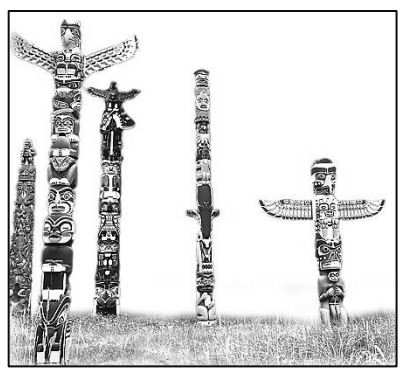Totem poles in North America are poles or posts carved with symbols or figures by Aboriginal peoples of the Northwest Coast. Carved from large, straight trees and painted vibrant colors, the totem poles are not just unique works of art. The coastal peoples have long passed on knowledge from generation to generation through oral traditions, and totem poles were the traditional way of telling the story of an individual family or clan.
The totem pole can be grouped into specific categories, depending on its location and the occasion for which it was carved. Welcome poles were traditionally placed on village beachfronts to greet visitors arriving by canoe. Inside the homes of high-ranking chiefs is where house poles were found. The family’s history was carefully carved into each pole. Placed along the rear or front walls of a house, house poles also helped to support the main beam of the roof.
Memorial poles stood in front of a house. They were erected in memory of a deceased chief or a high-ranking clan member. The poles depicted the person’s accomplishments or family history. Mortuary poles were also raised to honor the dead, but they differed from memorial poles, having a burial box placed at the top of the pole. Inside the burial box were the remains of the deceased.
While many of these poles can still be found in various locations on the west coast of North America, there is one pole that can now only be found in a museum—the shame pole. Traditionally, shame poles were carved for a chief to embarrass and ridicule another who had done something wrong. Once the wrong was made right, the pole was taken down.
Totem poles are important expressions of specific Aboriginal cultures. Despite the threats posed by cultural and political
encroachment of colonial forces, the art of totem pole carving has survived. Aboriginal carvers continue to carve totems as symbols of their cultural pride and clan kinship.
